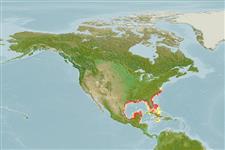Preferred temperature (Ref.
123201): 23.2 - 27, mean 25.5 °C (based on 272 cells).
Phylogenetic diversity index (Ref.
82804): PD
50 = 0.5039 [Uniqueness, from 0.5 = low to 2.0 = high].
Bayesian length-weight: a=0.00646 (0.00265 - 0.01571), b=3.06 (2.86 - 3.26), in cm total length, based on LWR estimates for this (Sub)family-body shape (Ref.
93245).
Τροφικό Επίπεδο (Ref.
69278): 3.5 ±0.42 se; based on food items.
Ελαστικότητα (Ref.
120179): Πολύ χαμηλό, ελάχιστος χρόνος για διπλασιασμό πληθυσμού > 14 έτη (K=0.26-0.31; Fec assumed <10).
Fishing Vulnerability (Ref.
59153): Very high vulnerability (90 of 100).
Nutrients (Ref.
124155): Calcium = 15.8 [2.1, 309.7] mg/100g; Iron = 0.739 [0.068, 8.595] mg/100g; Protein = 22.3 [20.0, 24.4] %; Omega3 = 0.199 [0.062, 0.591] g/100g; Selenium = 14.8 [2.7, 68.8] μg/100g; VitaminA = 6.9 [0.6, 69.4] μg/100g; Zinc = 0.726 [0.053, 8.530] mg/100g (wet weight); based on
nutrient studies. 